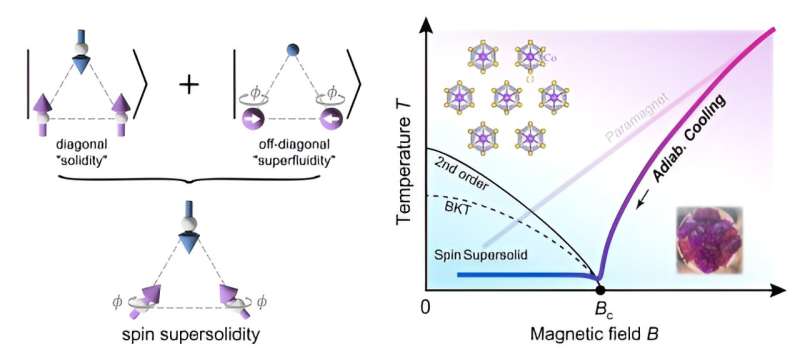January 29, 2024 report
This article has been reviewed according to Science X's editorial process and policies. Editors have highlighted the following attributes while ensuring the content's credibility:
fact-checked
peer-reviewed publication
trusted source
proofread
The first observation of a material exhibiting a supersolid phase of matter

Through experimental research, a team of physicists affiliated with multiple institutions in China has observed a material in a supersolid phase of matter for the first time. In their paper published in the journal Nature, the group describes the experiments they conducted to accomplish this feat and its implications. Nature has published a Research Briefing in the same journal issue outlining the work done by the team on this effort.
A supersolid is a seemingly contradictory material—it is defined as rigid, but also has superfluidity, in which a liquid flows without friction. In the 1970s, theoretical work by Anthony Leggett suggested that such a material might be possible. But until now, no one has been able to find it in nature or synthesize it in the lab.
To create a supersolid, the researchers involved in this new study started with a compound called NBCP—it has the unique attribute of atoms arranged in triangular lattices. This means, the research team found, that if it is placed within a magnetic field, all its atoms will spin in the same direction.
But when the magnet is removed, the atoms all try to orient themselves with a spin opposite that of their neighbor—but because they are arranged in a triangle, "frustration" arises because of the limited possible orientations. This observation suggested that under the right conditions, NBCP could exist as a supersolid.
To create the right conditions, the researchers built an apparatus to measure the magnetocaloric effect as the material was exposed to a magnetic field without fear of heat leaks. This allowed them to map the entropy state, which in turn allowed them to detect the spin states of the atoms and their transitions. They compared the findings with theoretical calculations and determined that they were on the right track.
They then carried out neutron diffraction measurements and compared them to theoretical calculations, and once again found agreement. Together, such measurements allowed them to conclude that they had observed a material in its supersolid state.
The observation is expected to open new possibilities for studying quantum phenomena and simulating novel materials.
More information: Junsen Xiang et al, Giant magnetocaloric effect in spin supersolid candidate Na2BaCo(PO4)2, Nature (2024). DOI: 10.1038/s41586-023-06885-w
Spin supersolid with giant magnetocaloric effect promises a new route to extreme cooling, Nature (2024). DOI: 10.1038/d41586-023-04102-2. www.nature.com/articles/d41586-023-04102-2
Journal information: Nature
© 2024 Science X Network




















